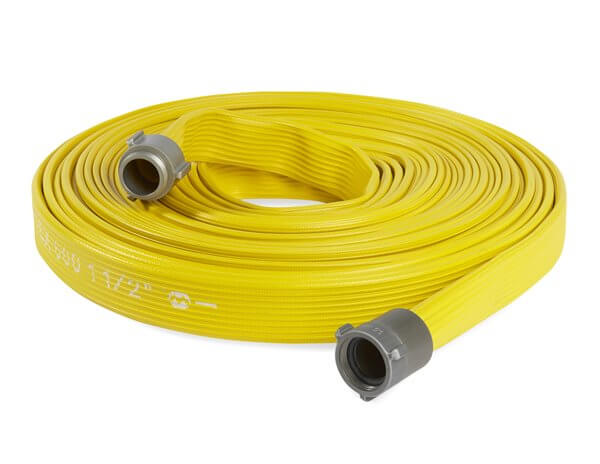UL19 & Can/ULC-S511-14 Certified
Meets or exceeds NFPA 1961 Fire Hose Standard
Applications:
Specially designed for municipal fire departments, navies, petrochemical, nuclear plants and other industrial services. Resistant to petroleum, chemicals, and abrasion.
Construction:
Made from circularly woven 100% high tenacity synthetic yarn, completely protected and locked-in by a tough, highly resistant synthetic nitrile rubber & PVC blend, extruded through the weave and forming a single homogeneous construction without the use of glues or adhesives.
Lining Properties:
The tensile strength of the lining and cover shall not be less than 1750 p.s.i. (12,000 kpa ), with an ultimate elongation of liner and cover not less than 450%.
Accelerated Aging:
Lining specimens subjected to an exposure of 158ºF ± 3.6ºF, for a duration of 96 hours shall be conditioned as per ASTM D 573, Standard Test Method for Rubber – Deterioration in an Air Oven. Then, the specimens shall be tested to ASTM D4112, Standard Test Methods for Vulcanized Rubber and Thermoplastic Elastomers- Tension, Method A. Upon evaluation, the tensile and elongation properties of the liner shall not be less than 75% of their initial values.
Abrasion Resistance:
IAs stated in NFPA 1961 (UL 19 & FM 2111), hose shall withstand 1-1/2 times the service test pressure without rupturing or breaking any thread in the jacket or reinforcement, after 300 cycles of abrasion for a single jacketed hose. Hose assembly shall also not leak or burst after 3000 cycles by an abrasion wheel.
Ozone Resistance:
No visible signs of cracking appear on the lining or cover when tested in accordance with ASTM D518-86, Standard Test Method for Rubber Deterioration-Surface Cracking, Procedure B, 100pphm/104ºF (40ºC).
Chemical Resistance:
Exposure to seawater and contamination by most chemical substances, hydrocarbons, oils and greases has no effect on the short or long term performance of the hose. A chemical resistance chart is available and TIPSA will supply specific chemical resistance data when requested by the purchaser for unique applications.
Service Temperature Range:
-4ºF (-20ºC) to 176ºF (80ºC). Special versions for higher and lower temperatures are available upon request.
Cold Resistance:
Hose shall have the capability of use down to -35º F (-37ºC). There shall be no apparent damage to jacket or lining when subjected to the following cold bend test: A 3-foot section of hose shall be exposed to a temperature of -35º F. for a period of 24 hours. At the end of the exposure period, the hose shall be rapidly bent 180 degrees back onto itself, first one way and then the other. Following this procedure, the hose shall not leak, nor show any damage to the jacket when subjected to the burst pressure shown.
Lengths:
Standard 50’ (15m), 100’ (30m). Special lengths up to 660ft (200m) are also available upon request.
Couplings:
As requested by purchaser; expansion-type, Storz , etc.
Heat Resistance:
The ability of the hose to resist heat shall be verified using the test procedures defined in UL 19, Lined Fire Hose and Hose Assemblies, Heat-Resistance Test and FM Class Number 2111, Factory Mutual Approval Standard for Fire Hose, Heat Resistance. Hose shall withstand 1112º F (600ºC) for at least two minutes without bursting when subjected to a static pressure of 100 psi (700 kPa), as per BS 6391, heat resistance test.
Inspection and Care:
NFPA advises users to develop a fire hose inspection and care program based on NFPA 1962, Standard for the Inspection, Care, and Use of Fire Hose, Couplings, and Nozzles and the Service Testing of Fire Hose, 2018 edition. Such program should also address the retirement of fire hose.
Branding:
Beginning at a point not less than 5’ ± 6” from each end, each length shall be stenciled with the manufacturer’s identification, country of origin, month and year of manufacture per NFPA 1961.

